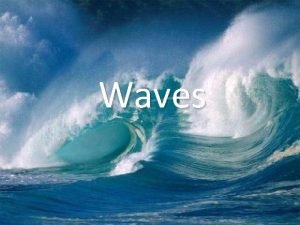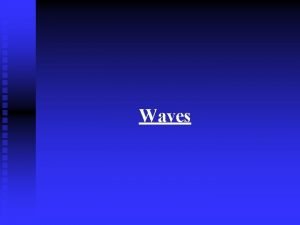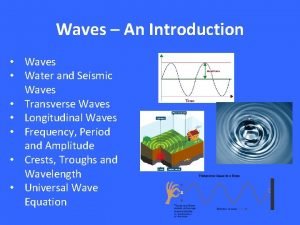Class Starter Waves 1 What are some examples






















- Slides: 22


Class Starter: Waves 1) What are some examples of waves in nature? 2) What are some variables that can be used to measure waves? 3) Do different types of waves exist? Explain. 4) Can you hear sounds in outer space? Explain your answer.

Class Starter- Waves 1) What are some examples of waves in nature? – ripples in a pond, a guitar string, an earthquake 2) What are some variables can we use to measure waves? – wavelength, frequency, amplitude 3) Do different types of waves exist? Explain. – – mechanical waves: longitudinal and transverse electromagnetic waves 4) Can you hear sounds in outer space? Explain your answer.

Wave a disturbance that propagates(travels) through a material medium or space. In order for a mechanical wave to exist, energy is needed to create a disturbance in an elastic medium. Waves transfer energy without the transport of matter.

No medium is needed for ELECTROMAGNETIC waves. Light, radio, x-rays, and gamma rays are some examples of e/m waves. All e/m waves travel through free space at a speed of approximately 3. 00 x 108 m/s or 186, 000 miles/sec. This speed is known as the speed of light.


TRANSVERSE The displacement of the particles of the medium is perpendicular to the direction of wave propagation. LONGITUDINAL The displacement of the particles of the medium is parallel to the direction of wave propagation.

Characteristics of Transverse Waves

Characteristics of Longitudinal Waves

Click here, and here to view simulations of transverse and longitudinal waves.

Amplitude the maximum displacement of a particle of the medium from the rest or equilibrium position denoted by A and measured in units of length

Wavelength is the length of a wave’s complete cycle denoted by l and measured in units of length

Frequency - the number of complete vibrations per unit time denoted by f and measured in units of Hz

Velocity - the speed of the wave denoted by v and measured in units of dist/time The speed of a wave depends on the properties of the medium through which it is traveling.

Reflection the turning back of a wave when it reaches the boundary of the medium through which it is traveling

Law of Reflection the angle of incidence is equal to the angle of reflection

Refraction the bending of a wave as it passes obliquely from one medium into another of different propagation speed For refraction to occur, the wave must change speed and must enter the new medium at an oblique angle.

Diffraction the spreading of a wave around a barrier or through an opening

A standing wave is the result of two wave trains of the same wavelength, frequency, and amplitude traveling in opposite directions through the same medium.

Learn more about standing waves here, and here. Click here to view a simulation of the interference of two traveling waves that can result in a standing wave. Click here to view a simulation of standing waves on a string. Standing waves may be produced easily in water, string, and air columns.

Doppler Effect the change in frequency due to the relative motion of the wave source and the observer The observed frequency is higher when the source and observer are getting closer. The observed frequency is lower when the source and observer are getting farther away.

Click here, and here to run simulations of the Doppler Effect. The Doppler Effect can be evident for all types of waves – including light, sound, water, etc…
 Antigentest åre
Antigentest åre Starter waves
Starter waves Lowest point of a wave
Lowest point of a wave Light waves are transverse waves true or false
Light waves are transverse waves true or false Venn diagram mechanical and electromagnetic waves
Venn diagram mechanical and electromagnetic waves Mechanical and electromagnetic waves similarities
Mechanical and electromagnetic waves similarities What type of waves are sound waves? *
What type of waves are sound waves? * Is echolocation transverse or longitudinal
Is echolocation transverse or longitudinal Short wave vs long wave radiation
Short wave vs long wave radiation Mechanical waves and electromagnetic waves similarities
Mechanical waves and electromagnetic waves similarities Mechanical vs electromagnetic
Mechanical vs electromagnetic Similarities of mechanical and electromagnetic waves
Similarities of mechanical and electromagnetic waves Seismic waves
Seismic waves Is a seismic wave mechanical or electromagnetic
Is a seismic wave mechanical or electromagnetic Compare and contrast p waves and s waves using venn diagram
Compare and contrast p waves and s waves using venn diagram Mechanical waves vs electromagnetic waves venn diagram
Mechanical waves vs electromagnetic waves venn diagram Constructive waves and destructive waves difference
Constructive waves and destructive waves difference They say sometimes you win some
They say sometimes you win some They say it only takes a little faith to move a mountain
They say it only takes a little faith to move a mountain Cake is countable or uncountable
Cake is countable or uncountable Contact forces
Contact forces Fire and ice diamante poem
Fire and ice diamante poem Some say the world will end in fire some say in ice
Some say the world will end in fire some say in ice










































